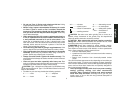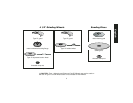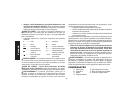
4. Move the tool constantly in a straight line to prevent burning and
swirling of work surface. Allowing the tool to rest on the work
surface without moving, or moving the tool in a circular motion
causes burning and swirling marks on the work surface.
5. Remove the tool from work surface before turning tool off. Allow
the tool to stop rotating before laying it down.
Precautions To Take When Sanding Paint
1. Sanding of lead based paint is NOT RECOMMENDED due to
the difficulty of controlling the contaminated dust. The greatest
danger of lead poisoning is to children and pregnant women.
2. Since it is difficult to identify whether or not a paint contains lead
without a chemical analysis, we recommend the following pre-
cautions when sanding any paint:
PERSONAL SAFETY
1. No children or pregnant women should enter the work area
where the paint sanding is being done until all clean up is com-
pleted.
2. A dust mask or respirator should be worn by all persons enter-
ing the work area. The filter should be replaced daily or when-
ever the wearer has difficulty breathing.
NOTE: Only those dust masks suitable for working with lead
paint dust and fumes should be used. Ordinary painting masks
do not offer this protection. See your local hardware dealer for
the proper N.I.O.S.H. approved mask.
3. NO EATING, DRINKING or SMOKING should be done in the
work area to prevent ingesting contaminated paint particles.
Workers should wash and clean up BEFORE eating, drinking or
smoking. Articles of food, drink, or smoking should not be left in
the work area where dust would settle on them.
4. Thread the assembled parts (clockwise) completely down on
the spindle.
5. Depress the spindle lock button while turning the sanding disc
until the sanding disc and clamp nut are snug.
6. To remove the wheel, grasp and turn the backing pad and
sanding disc while depressing the spindle lock button.
USING SANDING BACKING PADS
Choose the proper grit sanding disc for your application. Sanding
discs are available in various grits. Coarse grits yield faster material
removal rates and a rougher finish. Finer grits yield slower material
removal and a smoother finish.
Begin with lower grit discs for fast, rough material removal. Move to
a medium grit paper and finish with a fine grit disc for optimal finish.
Coarse 16 - 30 grit
Medium 36 - 80 grit
Fine Finishing 100 - 120 grit
Very Fine Finishing 150 - 180 grit
1. Allow the tool to reach full speed before touching tool to the
work surface.
2. Apply minimum pressure to work surface, allowing the tool to
operate at high speed. Sanding rate is greatest when the tool
operates at high speed.
3. Maintain a 5˚ to 15˚ angle between the
tool and work surface. The sanding
disc should contact approximately one
inch of work surface. The lower angle
will produce a smoother surface.
Using only the outer edge at a higher angle will produce an
irregular and bumpy finish. However, if the disc is used flat on
the surface, the tool will be difficult to control.
5˚-15˚
English
10


















